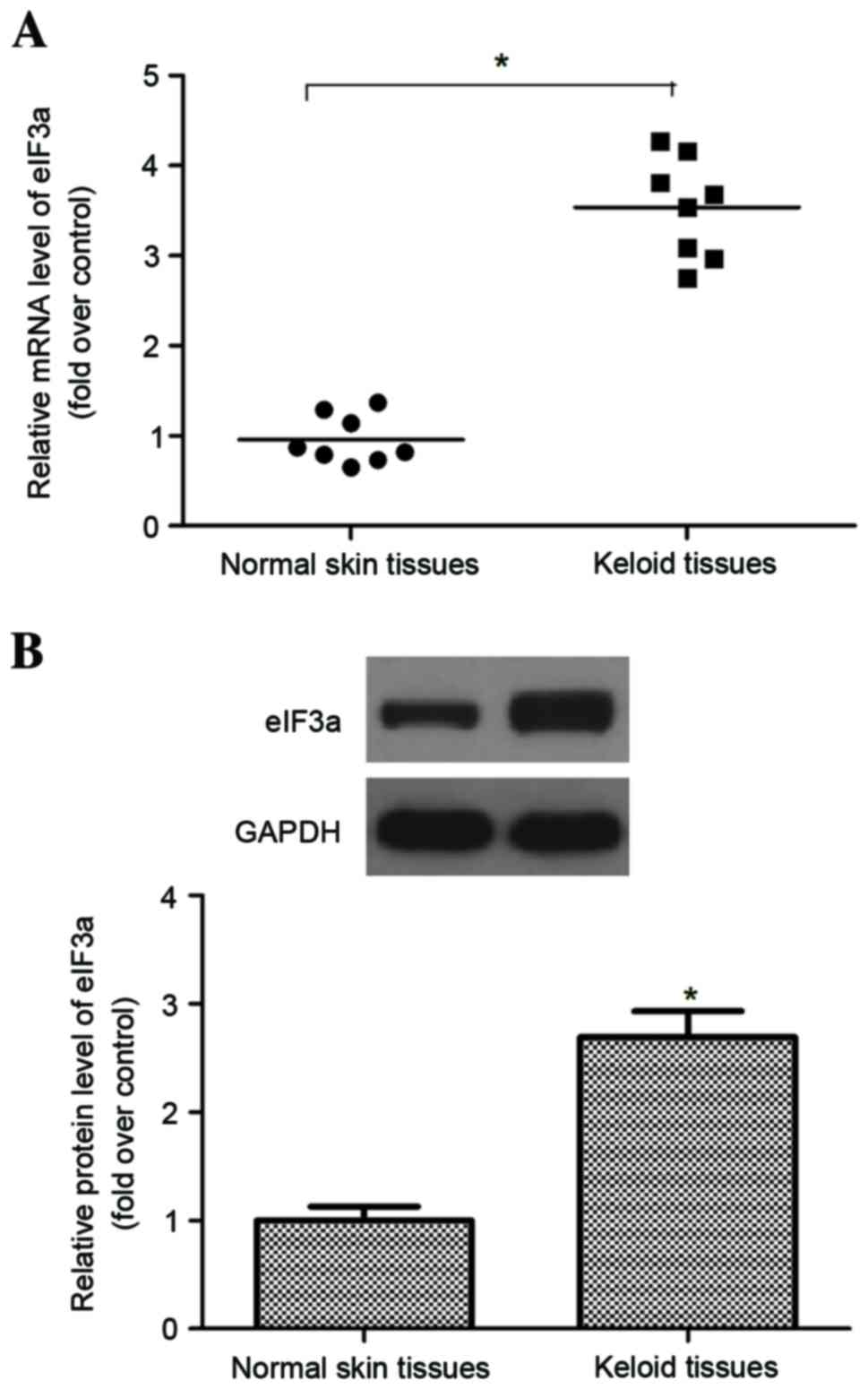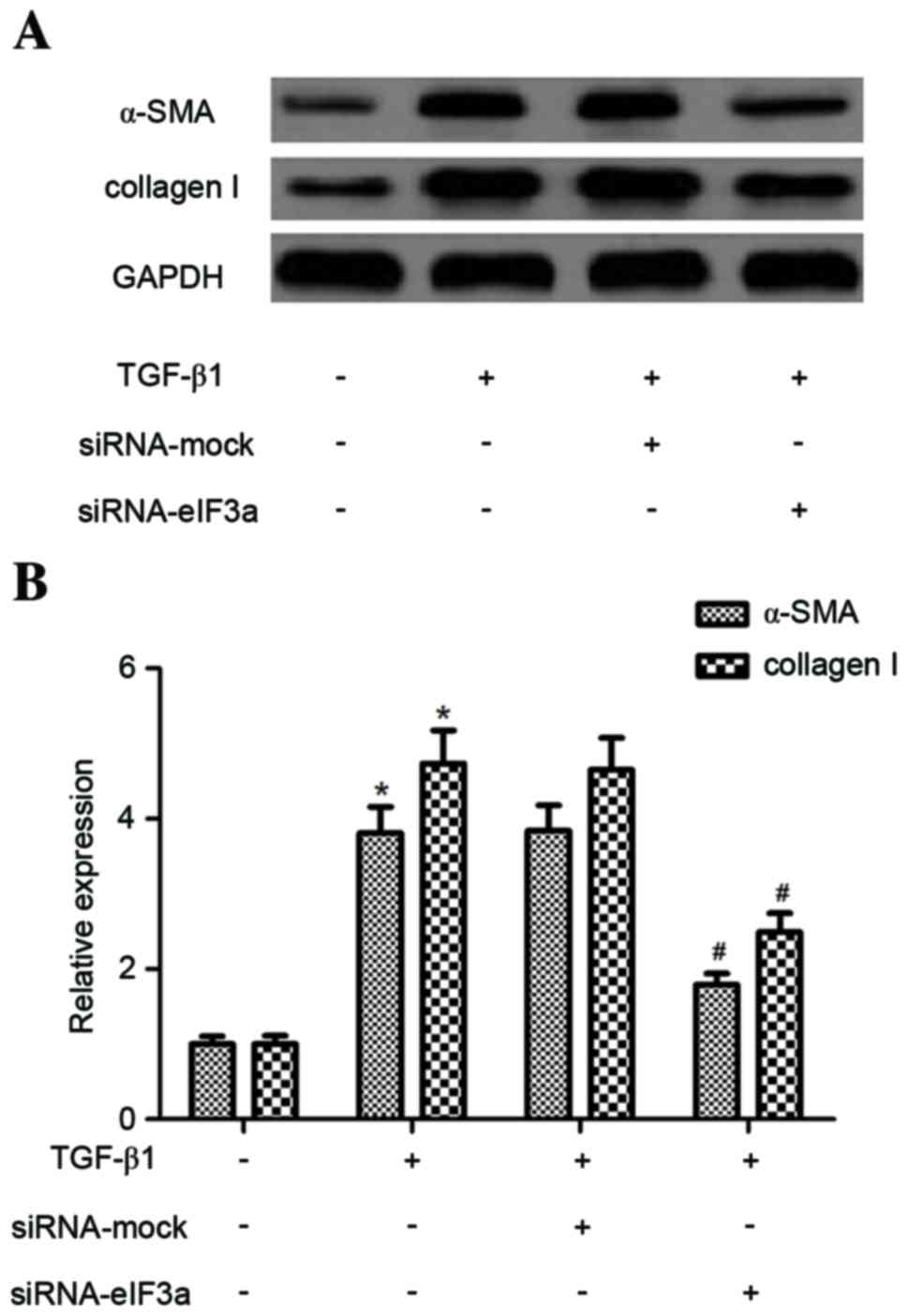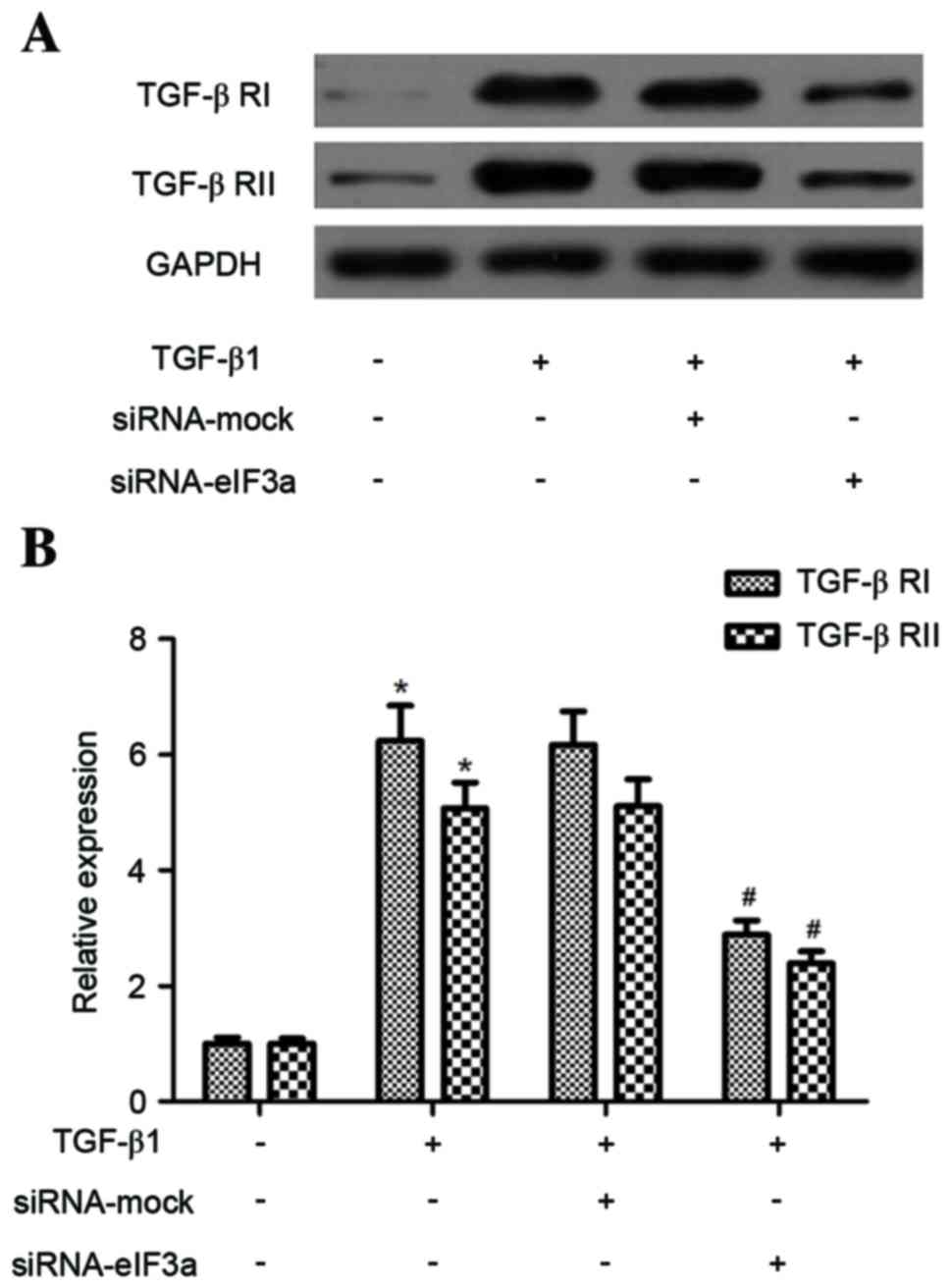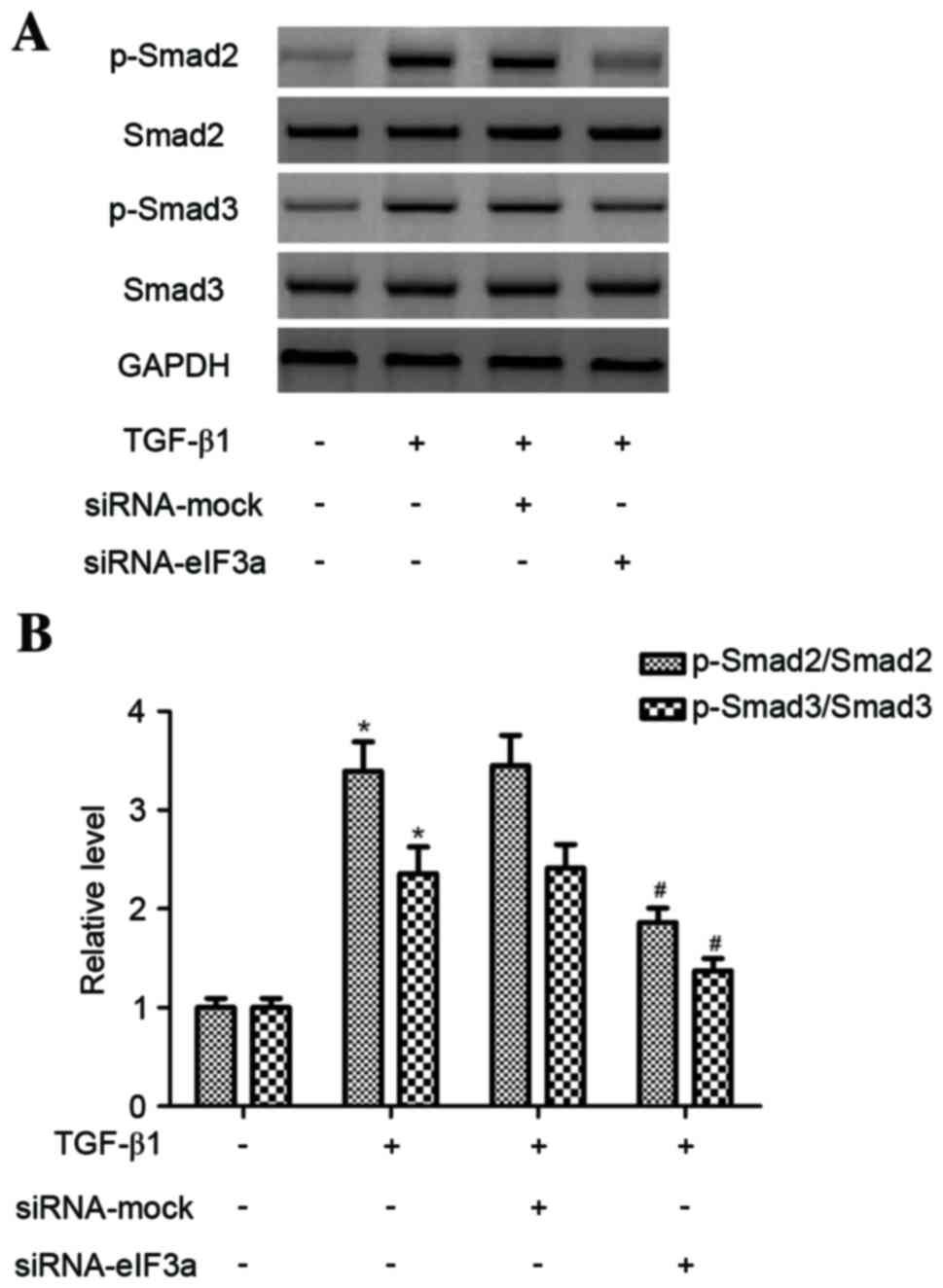Knockdown of elF3a inhibits TGF‑β1‑induced extracellular matrix protein expression in keloid fibroblasts
- Authors:
- Published online on: December 29, 2017 https://doi.org/10.3892/mmr.2017.8365
- Pages: 4057-4061
Abstract
Introduction
Keloids are a pathological wound healing response to cutaneous injury in genetically susceptible individuals. Keloid formation is characterized by hyperproliferation of secretory and responsive keloid fibroblasts (KFs), overproduction of extracellular matrix (ECM) (1). Although there are various methods widely applied for the treatment of keloids, including intralesional steroid injection, dermabrasion, pressure therapy, surgical excision, radiotherapy, cryotherapy, pulse dye, and carbon dioxide laser ablation (2,3), the pathogenesis of keloids is not fully understood and there is no standard treatment method. Accumulating data has demonstrated that the proliferation and migration of KFs are involved in keloid formation by synthesizing ECM (4–6).
Transforming growth factor (TGF)-β1 is one of the most important cytokines that promote keloid formation (7,8). Keloid-derived fibroblasts demonstrated a unique sensitivity to TGF-β, coupled with an increased expression of TGF-β1 and 2 and TGF-β type I and II receptors, and an increased proliferation and collagen production (9,10). Therefore, inhibiting the TGF-β1 pathway may have therapeutic potential for keloid treatment.
The eukaryotic translation initiation factor 3 subunit A (eIF3a) is one of the core subunits of the translation initiation complex eIF3, responsible for ribosomal subunit joining and mRNA recruitment to the ribosome (11). Multiple lines of evidence support that eIF3a is involved in regulating cell cycle and cell differentiation (12,13). For example, Liu et al (13) reported that the expression of eIF3a was significantly reduced in colon cancer cell lines prior to differentiation. The overexpression of eIF3a inhibited the progression of colon cancer; however, eIF3a knockdown greatly induced colon cancer cell differentiation (13). In addition, it was reported that knockdown of elF3a inhibits collagen synthesis in renal fibroblasts via inhibition of TGF-β1/Smad signaling pathway (14). However, the role of eIF3a in keloid formation has not yet been investigated. Therefore, in the current study, the effect of eIF3a on TGF-β1-mediated ECM production in KFs was examined. The present study demonstrated that eIF3a was highly expressed in human keloid tissues, and knockdown of eIF3a efficiently suppressed ECM expression in KFs, at least in part, via the TGF-β1/Smad signaling pathway. Thus, eIF3a may be a potential target for treatment of keloids.
Materials and methods
Tissue sample collection
Fresh keloid and normal skin samples were obtained from 8 healthy subjects with keloid and another 8 healthy subjects. All the subjects were patients of the Department of Burns and Plastic Surgery, Plastic and Cosmetic Center, Nanyang Nanshi Hospital, Affiliated Hospital of Henan University (Nanyang, China). The present study was approved by Ethics Committee of Nanyang Nanshi Hospital. Informed consent was obtained from all individual subjects for all procedures.
KF culture
Primary KF cultures were established as previously described (15). The specimens were digested in Dulbecco's modified Eagle's medium (DMEM; Invitrogen; Thermo Fisher Scientific, Inc., Waltham, MA, USA) with 0.5% dispase overnight at 4°C, then cultured in DMEM with 10% FBS (Gibco; Thermo Fisher Scientific, Inc.), 100 U/ml penicillin and 0.1 g/ml streptomycin at 37°C in a humidified incubator with 5% CO2.
Transfection of small interfering (si)RNA
siRNA-eIF3a (5′-GCAGATGGTCTTAGATATA-3′) and the non-silencing control siRNA (siRNA-mock, 5′-GCAAAAAATGGGTTTTCGT-3′) were purchased from Cell Signaling Technology, Inc. (Danvers, MA, USA). For in vitro transfection, KFs were plated and cultures to 70–90% confluency without antibiotics, and then incubated with a mixture of siRNA and Lipofectamine 2000 reagent (Invitrogen; Thermo Fisher Scientific, Inc.) in 100 µl serum-free DMEM, according to the manufacturer's instructions. The cells were harvested with extraction buffer after transfection for 48 h. The relative expression of eIF3a was determined using western blot analysis.
Cell proliferation assay
Cell proliferation was determined using Cell Counting Kit-8 (CCK-8; Beyotime Institute of Biotechnology, Haimen, China) according to manufacturer's instructions. In brief, KFs at a density of 1×104 cells/well were transfected with siRNA-eIF3a or siRNA-mock, and treated with TGF-β1 (10 ng/ml). Following cultivation for 72 h, CCK-8 solution (10 µl) was added to each well and the plates were incubated for 2 h. The absorbance was determined at 490 nm (optical density value) using a Synergy HT microplate reader (Thermo Fisher Scientific, Inc.).
Reverse transcription-quantitative polymerase chain reaction (RT-qPCR)
Total RNA was isolated from keloid tissues and KFs using the TRIzol® Plus RNA Purification kit (Invitrogen; Thermo Fisher Scientific, Inc.). Complementary DNA was synthesized from 2 µg of total RNA with an AMV reverse transcriptase kit (Promega Corporation, Madison, WI, USA) according to the manufacturer's instructions. RT-qPCR amplification was carried out on an IQ5 real-time PCR system (Bio-Rad Laboratories, Inc., Hercules, CA, USA) using a SYBR Premix Ex Taq kit (Takara Biotechnology Co., Ltd., Dalian, China) following the manufacturer's instructions. The specific primers used were as follows: eIF3a sense, 5′-TCAAGTCGCCGGACGATA-3′ and anti-sense, 5′-CCTGTCATCAGCACGTCTCCA-3′; and for β-actin were sense, 5′-AAATCGTGCGTGACATCAAAGA-3′ and antisense, 5′-GGCCATCTCCTGCTCGAA-3′. The PCR cycling program was 95°C for 5 min, then 35 cycles of 94°C for 20 sec, 59°C for 20 sec and 72°C for 25 sec, and a final extension at 72°C for 4 min. The specificity of the PCR product was examined by dissociation curve analysis, and the relative quantification of gene expression was analyzed by the 2−ΔΔCq method (16) and normalized to β-actin that served as internal standard.
Western blot analysis
The proteins were extracted from keloid tissues and KFs using radioimmunoprecipiation assay lysis buffer (Beyotime Institute of Biotechnology, Haimen, China) according to the manufacturer's instructions. Protein concentration was determined using the Bradford method. Protein samples (20 µg) were separated by 10% SDS-polyacrylamide gel electrophoresis and transferred to nitrocellulose membranes (GE Healthcare Life Sciences, Little Chalfont, UK). After blocking with 10% fat-free milk in TBS-Tween [20 mmol/l Tris, 0.15 mol/l NaCl (pH 7.0), 0.1% Tween-20], the membranes were incubated with primary antibodies [anti-eIF3a (1:3,000, sc-376651), anti-α-smooth muscle actin (SMA, 1:2,500, sc-53142) (both from Santa Cruz Biotechnology, Inc., Dallas, TX, USA), anti-collagen I (1:3,000, SAB4200678), anti-TGF-β RI (1:3,000, SAB4502958), and anti-TGF-β RII (1:2,500; SAB4504269) (all from Sigma-Aldrich; Merck KGaA, Darmstadt, Germany) anti-Smad2 (1:2,500, sc-101153; Santa Cruz Biotechnology, Inc.), anti-phospho (p)-Smad2 (1:3,000, SAB4301395; Sigma-Aldrich; Merck KGaA), anti-Smad3 (1:1,500, sc-101154; Santa Cruz Biotechnology, Inc.), anti-p-Smad3 (1:3,000, SAB4301395; Sigma-Aldrich; Merck KGaA) and anti-GAPDH (1:3,000, sc-59540; Santa Cruz Biotechnology, Inc.) at 4°C overnight. Membranes were then washed and incubated with horseradish peroxidase-conjugated secondary antibodies (1:2,500, sc-2005; Santa Cruz Biotechnology, Inc.) for 1 h at room temperature. Proteins were visualized using the enhanced chemiluminescence western blotting detection system according to the manufacturer's protocol (GE Healthcare Life Sciences). Quantification analysis was performed using Gel-Pro Analyzer software (version 4.0; Media Cybernetics, Inc., Rockville, MD, USA).
Statistical analysis
All data are expressed as the mean ± standard deviation based on at least three independent experiments. The significance of differences was analyzed using Student's t-test or by one-way analysis of variance followed by a Tukey's post hoc test. P<0.05 was considered to indicate a statistically significant difference.
Results
eIF3a is highly expressed in human keloid tissues
To investigate the role of eIF3a in keloid pathogenesis, the expression of eIF3a in keloid tissues was measured using RT-qPCR and western blot analyses. The data demonstrated that the mRNA expression of eIF3a in keloids was significantly higher than those in normal skin (P<0.05; Fig. 1A). Similarly, western blot analysis demonstrated that the protein of eIF3a in keloid was also significantly higher than those in normal skin (P<0.05; Fig. 1B).
Effects of eIF3a on KF proliferation
In order to investigate the effect of eIF3a on cell proliferation and migration in TGF-β1-induced KFs, an eIF3a siRNA was used to knockdown the expression of eIF3a. As presented in Fig. 2A, siRNA-eIF3a significantly decreased the expression levels of eIF3a in KFs compared with the control group and mock siRNA (P<0.05). The effect of eIF3a silencing on KF proliferation induced by TGF-β1 was then examined. The results indicated that TGF-β1 treatment promoted KF proliferation compared with the control group. Whereas the cell proliferation induced by TGF-β1 was inhibited in eIF3a-silenced KFs compared with cells transfected with the mock control siRNA (P<0.05; Fig. 2B).
Effect of eIF3a on the expression of α-SMA and collagen in human KFs
Subsequently, the effect of eIF3a on α-SMA and collagen I protein levels in TGF-β1-induced KFs was examined. As demonstrated in Fig. 3, TGF-β1 produced a significant increase in the expression of α-SMA and collagen I compared with untreated cells (P<0.05). However, eIF3a silencing significantly suppressed the TGF-β1-induced expression levels of α-SMA and collagen I when compared with the TGF-β1 + siRNA mock group (P<0.05).
Effect of eIF3a on the expression of TGF-β1 receptor (TGF-β R) I and II in human keloid fibroblasts
Next, the effect of eIF3a on TGF-β receptor I (TGF-β RI) and II expression levels in TGF-β1-stimulated KFs was examined. As demonstrated in Fig. 4, TGF-β1 significantly increased TGF-β RI and TGF-β RII expression in KFs when compared with the control group (P<0.05). However, eIF3a silencing dramatically suppressed the TGF-β1-enhanced TGF-β RI and TGF-β RII expression in KFs, compared to the TGF-β1 + siRNA-mock group (P<0.05).
Effect of eIF3a on phosphorylation of Smad3 in human KFs
To further explore the intracellular signaling pathway, the effect of eIF3a on TGF-β1-induced Smad2 and Smad3 phosphorylation in KFs was investigated. As presented in Fig. 5, the phosphorylation of Smad2 and Smad3 increased in TGF-β1-treated KFs compared to the control group (P<0.05). However, eIF3a silencing inhibited the phosphorylation levels of Smad2 and Smad3 in TGF-β1-induced KFs compared with the TGF-β1 + siRNA-mock group (P<0.05).
Discussion
In the present study, a significant upregulation of eIF3a mRNA and protein in human keloid tissues was observed when compared with normal tissues. Knockdown of eIF3a inhibited KF proliferation induced by TGF-β1. In addition, eIF3a silencing significantly suppressed TGF-β1-induced expression of α-SMA and collagen I, as well as expression of TGF-β RI and TGF-β RII in KFs. In addition, eIF3a silencing inhibited the phosphorylation levels of Smad2 and Smad3 in TGF-β1-induced KFs.
Previous studies identified that eIF3a has a critical role in fibrotic disease. Li et al (17) reported that the expression of eIF3a was obviously increased in the lungs of rats with pulmonary fibrosis, and detected upregulation of α-SMA and collagens. An additional study demonstrated that the expression of eIF3a was significantly increased in the right ventricle (RV) of RV remodeling rats (18). In line with these results, the present study identified that there was upregulation of eIF3a mRNA and protein and in human keloid tissues, which suggested that eIF3a may be useful as a potential biomarker for keloid formation.
It was previously reported that the proliferation ability of KFs was higher than that of normal skin fibroblasts (19). In addition, application of exogenous TGF-β1 induces cell proliferation in cultured cardiac fibroblasts and pulmonary fibroblasts, and the effect of TGF-β1-induced proliferation is abolished by eIF3a siRNA (17,18). Consistent with these previous studies, the present study observed that TGF-β1 treatment promoted KF proliferation, whereas, knockdown of eIF3a significantly inhibited KF proliferation induced by TGF-β1.
Previous studies demonstrated that the excessive ECM deposition derived from fibroblasts in the skin is the major histopathological characteristic of keloids (20–22). In addition, TGF-β1 has been demonstrated to greatly increase the expression of ECM proteins in KFs (21). Similarly, in the present study, it was identified that TGF-β1 increased the expression levels of α-SMA and collagen I; however, eIF3a silencing significantly suppressed TGF-β1-induced the expression levels of α-SMA and collagen I in KFs. These results suggested that siRNA-eIF3a exhibits a suppressive effect on α-SMA and collagen I expression in KFs in the presence of TGF-β1. Therefore, α-SMA may serve a specific role in keloid formation.
Multiple lines of evidence support that the TGF-β1/Smad signaling pathway has an important role in keloid formation (23–25). Upon phosphorylation by TGF-β receptors, Smad2 and Smad3, known as receptor R-Smads, form heteromeric complexes with Co-Smad or Smad4, and the Smad complex translocates into the nucleus where it regulates the expression of target genes (26). KFs have been reported to express higher levels of TGF-β RI and TGF-β RII than normal dermal fibroblasts (10). Previous studies have indicated that Smad2 and Smad3 are overexpressed and highly phosphorylated in KFs compared with normal fibroblasts, and inhibition of Smad2 and Smad3 may decrease the expression of type I and III procollagen in keloids (10,27,28). The current novel data reveal that TGF-β1 treatment markedly increased the expression of TGF-β RI and TGF-β RII, and this enhancing effect was inhibited by siRNA-eIF3a in KFs. In addition, an increase of p-Smad2 and p-Smad3 induced by TGF-β1 was reversed by siRNA-eIF3a. These results suggest that siRNA-eIF3a inhibits ECM expression via the TGF-β1/Smad signaling pathway in KFs.
In conclusion, the current results demonstrate that siRNA-eIF3a inhibits ECM expression in KFs and the effect may be mediated via the TGF-β1/Smad signaling pathway. Thus, eIF3a may be a potential target for treatment of keloids.
References
|
Seifert O and Mrowietz U: Keloid scarring: Bench and bedside. Arch Dermatol Res. 301:259–272. 2009. View Article : Google Scholar : PubMed/NCBI | |
|
English RS and Shenefelt PD: Keloids and hypertrophic scars. Dermatol Surg. 25:631–638. 1999. View Article : Google Scholar : PubMed/NCBI | |
|
Gauglitz GG, Korting HC, Pavicic T, Ruzicka T and Jeschke MG: Hypertrophic scarring and keloids: Pathomechanisms and current and emerging treatment strategies. Mol Med. 17:113–125. 2011. View Article : Google Scholar : PubMed/NCBI | |
|
Fang F, Huang RL, Zheng Y, Liu M and Huo R: Bone marrow derived mesenchymal stem cells inhibit the proliferative and profibrotic phenotype of hypertrophic scar fibroblasts and keloid fibroblasts through paracrine signaling. J Dermatol Sci. 83:95–105. 2016. View Article : Google Scholar : PubMed/NCBI | |
|
Wu CS, Wu PH, Fang AH and Lan CC: FK506 inhibits the enhancing effects of transforming growth factor (TGF)-β1 on collagen expression and TGF-β/Smad signaling in keloid fibroblasts: Implication for new therapeutic approach. Br J Dermatol. 167:532–541. 2012. View Article : Google Scholar : PubMed/NCBI | |
|
Makino S, Mitsutake N, Nakashima M, Saenko VA, Ohtsuru A, Umezawa K, Tanaka K, Hirano A and Yamashita S: DHMEQ, a novel NF-kappaB inhibitor, suppresses growth and type I collagen accumulation in keloid fibroblasts. J Dermatol Sci. 51:171–180. 2008. View Article : Google Scholar : PubMed/NCBI | |
|
Bran GM, Sommer UJ, Goessler UR, Hörmann K, Riedel F and Sadick H: TGF-β1 antisense impacts the SMAD signalling system in fibroblasts from keloid scars. Anticancer Res. 30:3459–3463. 2010.PubMed/NCBI | |
|
Chalmers RL: The evidence for the role of transforming growth factor-beta in the formation of abnormal scarring. Int Wound J. 8:218–223. 2011. View Article : Google Scholar : PubMed/NCBI | |
|
Peltonen J, Hsiao LL, Jaakkola S, Sollberg S, Aumailley M, Timpl R, Chu ML and Uitto J: Activation of collagen gene expression in keloids: Co-localization of type I and VI collagen and transforming growth factor-beta 1 mRNA. J Invest Dermatol. 97:240–248. 1991. View Article : Google Scholar : PubMed/NCBI | |
|
Chin GS, Liu W, Peled Z, Lee TY, Steinbrech DS, Hsu M and Longaker MT: Differential expression of transforming growth factor-beta receptors I and II and activation of Smad 3 in keloid fibroblasts. Plast Reconstr Surg. 108:423–429. 2001. View Article : Google Scholar : PubMed/NCBI | |
|
Saletta F, Suryo Rahmanto Y and Richardson DR: The translational regulator eIF3a: The tricky eIF3 subunit! Biochim Biophys Acta 1806. 1–286. 2010. | |
|
Dong Z, Liu Z, Cui P, Pincheira R, Yang Y, Liu J and Zhang JT: Role of eIF3a in regulating cell cycle progression. Exp Cell Res. 315:1889–1894. 2009. View Article : Google Scholar : PubMed/NCBI | |
|
Liu Z, Dong Z, Yang Z, Chen Q, Pan Y, Yang Y, Cui P, Zhang X and Zhang JT: Role of eIF3a (eIF3 p170) in intestinal cell differentiation and its association with early development. Differentiation. 75:652–661. 2007. View Article : Google Scholar : PubMed/NCBI | |
|
Zhang YF, Wang Q, Luo J, Yang S, Wang JL and Li HY: Knockdown of elF3a inhibits collagen synthesis in renal fibroblasts via Inhibition of transforming growth factor-β1/Smad signaling pathway. Int Clin Exp Pathol. 8:8983–8989. 2015. | |
|
Ishihara H, Yoshimoto H, Fujioka M, Murakami R, Hirano A, Fujii T, Ohtsuru A, Namba H and Yamashita S: Keloid fibroblasts resist ceramide-induced apoptosis by overexpression of insulin-like growth factor I receptor. J Invest Dermatol. 115:1065–1071. 2000. View Article : Google Scholar : PubMed/NCBI | |
|
Livak KJ and Schmittgen TD: Analysis of relative gene expression data using real-time quantitative PCR and the 2(-Delta Delta C(T)) method. Methods. 25:402–408. 2001. View Article : Google Scholar : PubMed/NCBI | |
|
Li XW, Wu YH, Li XH, Li D, Du J, Hu CP and Li YJ: Role of eukaryotic translation initiation factor 3a in bleomycin-induced pulmonary fibrosis. Eur J PharSmacol. 749:89–97. 2015. View Article : Google Scholar | |
|
Li WQ, Li XH, Wu YH, Du J, Wang AP, Li D and Li YJ: Role of eukaryotic translation initiation factors 3a in hypoxia-induced right ventricular remodeling of rats. Life Sci. 144:61–68. 2016. View Article : Google Scholar : PubMed/NCBI | |
|
Younai S, Nichter LS, Wellisz T, Reinisch J, Nimni ME and Tuan TL: Modulation of collagen synthesis by transforming growth factor-[beta] in keloid and hypertrophic scar fibroblasts. Ann Plast Surg. 33:148–154. 1994. View Article : Google Scholar : PubMed/NCBI | |
|
Sidgwick G and Bayat A: Extracellular matrix molecules implicated in hypertrophic and keloid scarring. J Eur Acad Dermatol Venereol. 26:141–152. 2012. View Article : Google Scholar : PubMed/NCBI | |
|
Babu M, Diegelmann R and Oliver N: Keloid fibroblasts exhibit an altered response to TGF-beta. J Invest Dermatol. 99:650–655. 1992. View Article : Google Scholar : PubMed/NCBI | |
|
Fujiwara M, Muragaki Y and Ooshima A: Keloid-derived fibroblasts show increased secretion of factors involved in collagen turnover and depend on matrix metalloproteinase for migration. Br J Dermatol. 153:295–300. 2005. View Article : Google Scholar : PubMed/NCBI | |
|
Hsu YC, Chen MJ, Yu YM, Ko SY and Chang CC: Suppression of TGF-β1/SMAD pathway and extracellular matrix production in primary keloid fibroblasts by curcuminoids: Its potential therapeutic use in the chemoprevention of keloid. Arch Dermatol Res. 302:717–724. 2010. View Article : Google Scholar : PubMed/NCBI | |
|
Mun JH, Kim YM, Kim BS, Kim JH, Kim MB and Ko HC: Simvastatin inhibits transforming growth factor-β1-induced expression of type I collagen, CTGF, and α-SMA in keloid fibroblasts. Wound Repair Regen. 22:125–133. 2014. View Article : Google Scholar : PubMed/NCBI | |
|
Hou Q, He WJ, Hao HJ, Han QW, Chen L, Dong L, Liu JJ, Li X, Zhang YJ, Ma YZ, et al: The four-herb Chinese medicine ANBP enhances wound healing and inhibits scar formation via bidirectional regulation of transformation growth factor pathway. PLoS One. 9:e1122742014. View Article : Google Scholar : PubMed/NCBI | |
|
Derynck R and Zhang YE: Smad-dependent and Smad-independent pathways in TGF-beta family signalling. Nature. 425:577–584. 2003. View Article : Google Scholar : PubMed/NCBI | |
|
Phan TT, Lim IJ, Aalami O, Lorget F, Khoo A, Tan EK, Mukhopadhyay A and Longaker MT: Smad3 signalling plays an important role in keloid pathogenesis via epithelial-mesenchymal interactions. J Pathol. 207:232–242. 2005. View Article : Google Scholar : PubMed/NCBI | |
|
Wang Z, Gao Z, Shi Y, Sun Y, Lin Z, Jiang H, Hou T, Wang Q, Yuan X, Zhu X, et al: Inhibition of Smad3 expression decreases collagen synthesis in keloid disease fibroblasts. J Plast Reconstr Aesthet Surg. 60:1193–1199. 2007. View Article : Google Scholar : PubMed/NCBI |














